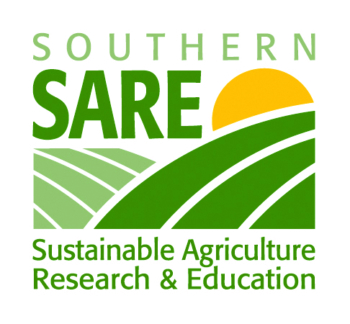Regenerative Grazing in the South: Case Studies from Texas
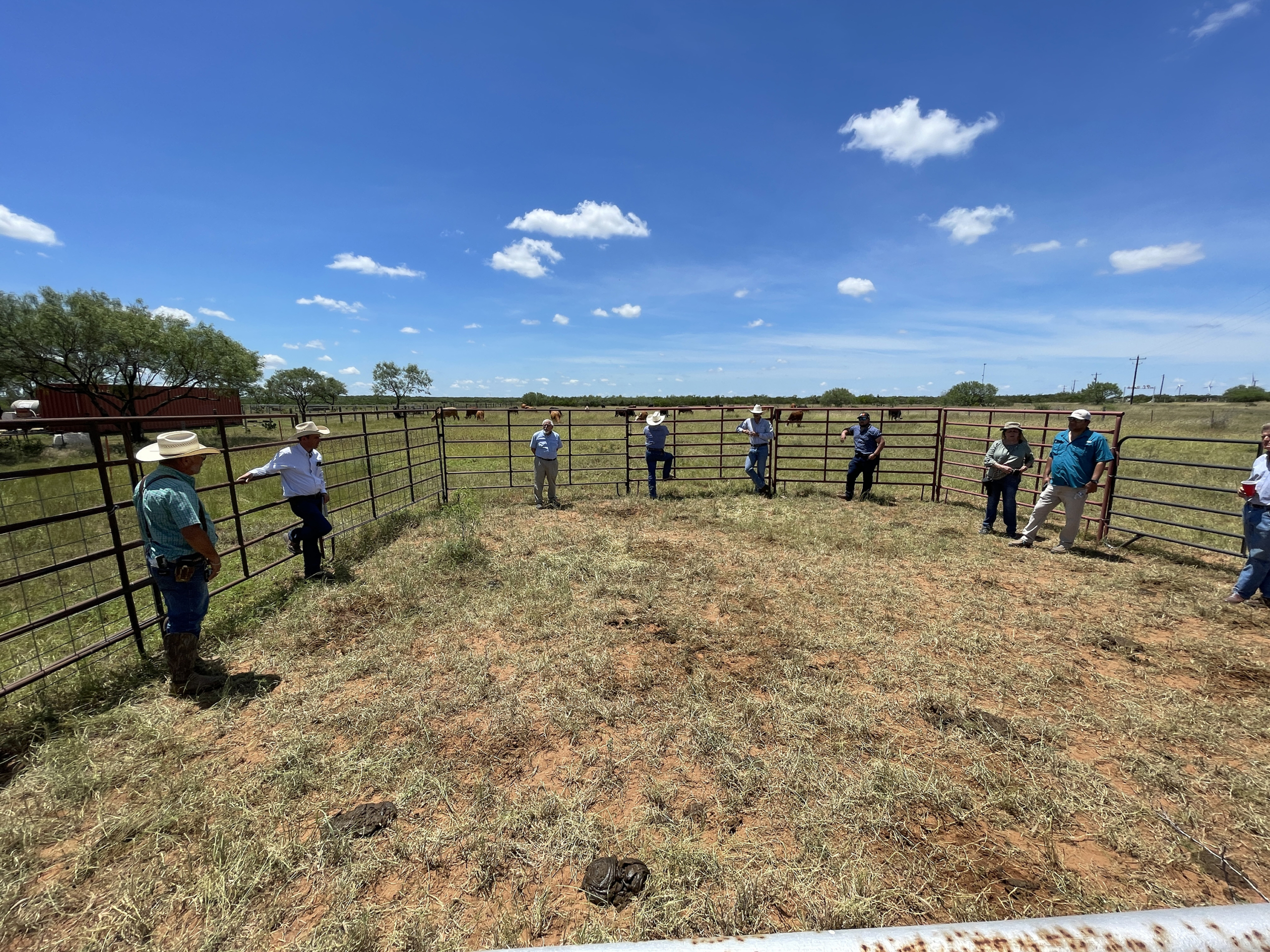
Peer-to-peer learning at Servando Leal’s ranch near Bruni, Texas. Photo: Darron Gaus, NCAT
By Peggy Sechrist, Texas Soil for Water Project Coordinator, and Darron Gaus, NCAT Sustainable Agriculture Specialist
Abstract
Regenerative grazing builds soil health and improves water infiltration and storage. It holds great promise for ranchers coping with drought, torrential rain events, and an unpredictable climate, but it has been slow to catch on in Texas. This publication explains some historical factors that have created barriers to adoption and profiles a working group and four innovative ranchers who are overcoming those barriers: experimenting with new methods, challenging the “status quo,” and supporting each other with peer-to-peer learning. Overall, the publication paints a picture of how and why regenerative grazing is overcoming resistance, gaining traction, and emerging as a new paradigm in Texas.
Contents
Introduction
Regenerative Grazing in Texas
Safe to Fail Trials
Case Study: Lauri Celella
Case Study: Servando Leal
The Texas Trials
Case Study: Ward Whitworth
Case Study: Richard Smith and Sean Kendrick, Stowers Ranch
A New Paradigm Emerging in Texas
References
Further Resources
Introduction
From 2010 until 2015, Texas experienced what the National Oceanic and Atmospheric Administration (NOAA) called a “wild hydrological rollercoaster,” with eruptions of heavy rain and lengthy periods when the tap shut off altogether. Responding to these events, the National Center for Appropriate Technology (NCAT) launched the Soil for Water project in 2015 to help landowners improve soil health and enable their soil to catch and hold more water. Since that time, Texas has seen many of the same conditions: extreme drought, deluge rain events, and a 2024 wildfire that rushed through the prairies, taking out barns and equipment and threatening livelihoods.
During both drought and flooding events, well-aggregated soil can capture more water than poorly aggregated soil. The Soil for Water project has been attempting to raise awareness of this and encourage experimentation on farms and ranches throughout the South that are coping with increasingly uncertain climatic conditions.
The project emphasizes and promotes five soil health principles:
- Keep soil covered.
- Manage soil disturbance.
- Increase biodiversity.
- Maintain living plants.
- Integrate livestock.
This publication highlights four Texas ranchers who have been working to regenerate their land and sustain their lifestyles in an era of climate uncertainty. It includes stories of ranchers using small-scale, low-risk grazing experiments to evaluate high-intensity grazing, as well as ranchers who have been trying to catch more water in their soil during times of drought. Together, these case studies provide a snapshot of the real-world experience of Texas ranchers: the barriers they face, how they are learning, and how the ideas and methods of regenerative grazing are gradually overcoming resistance, spreading, and catching on in Texas.
Regenerative Grazing in Texas
Grazing in Texas goes back beyond any recorded history. Bison and other wild ungulates roamed and grazed the grasslands of Texas for thousands of years before European immigration began. The settling of Texas by European—especially German—immigrants during the early 1800s is a well-known story, and many of these hardy people took up raising livestock for a living. Naturally, the European settlers managed grazing just as they had in their European homelands, where humidity and rainfall were reliable. They had no knowledge of semi-arid and arid environments and the possibility that land in Texas would respond differently to grazing than their land back home. This knowledge gap opened space for a process of soil degradation that was not well understood until recent years.
Unique factors about Texas, such as size, terrain, ecological variations, differing cultural legacies, climate, and historic tensions and conflict with both the Mexican government and Native peoples, all affected the early settlers. These factors created a culling system so intense that only the most fiercely determined and independent immigrants survived, and eventually thrived, in the state. These qualities were passed down and endure to this day in many rural areas of Texas, where “the way granddad did it is good enough for me” has become the standard. A natural-born resistance to change has been embedded into a rural culture that hasn’t kept up with the emerging science of soil health and grazing practices.
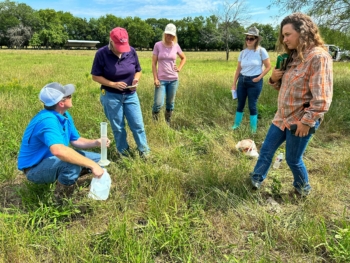
Water infiltration testing. Photo: Darron Gaus, NCAT
In 2021, the Southern Sustainable Agriculture Research and Education Program (Southern SARE) awarded a three-year “systems research” grant to NCAT for the purpose of exploring barriers to the adoption of regenerative grazing and accelerating adoption of those methods in four southern states: Arkansas, Mississippi, Texas, and Virginia. The authors of this publication, Peggy Sechrist and Darron Gaus, had the pleasure of co-leading the Texas working group. This intentionally diverse working group included ranchers, agriculture-focused non-governmental organizations, university researchers, and agricultural agency representatives from various Texas eco-regions and cultures, as well as gender diversity.
In an initial survey, the working group ranked “going against the status quo” as the primary barrier they saw to the adoption of regenerative grazing practices in Texas. The second barrier identified by the group was “lack of evidence/information” about the benefits of regenerative grazing. These recognized barriers became the foundation for the working group’s course of action over the three years of the project. Taking a peer-to-peer approach, working group members tackled the difficulty of going against the “status quo” and the lack of definitive evidence. They learned from each other, visited each other’s properties, and became champions and mentors for other producers in Texas.
Safe to Fail Trials
The Texas working group was unanimous in its decision to focus on conducting Safe to Fail Trials as a low-risk way to evaluate the principles of regenerative grazing and provide evidence of its benefits. The Safe to Fail Trial concept came from an Australian Holistic Management International (HMI) Certified Educator, Graeme Hand. Encountering resistance in his own country to the idea of regenerative grazing, Graeme designed trials to allow producers to engage in a site-specific grazing experiment without risk to their overall operation.
A Safe to Fail Trial is a very small-scale experiment requiring a minimal investment of labor and money. Producers herd livestock into a small, fenced area where they are tightly packed for a few hours, then move them out of the pen and exclude them from the heavily trampled ground for several months. During this period without grazing, landowners can observe the effects of high-density grazing with an extended recovery time. In some cases, producers see dramatic vegetation changes, improved land function, and more water being captured and stored in the soil. In all cases, producers get evidence they can trust about how their land responds to high-density grazing. They see it with their own eyes and on their own land.
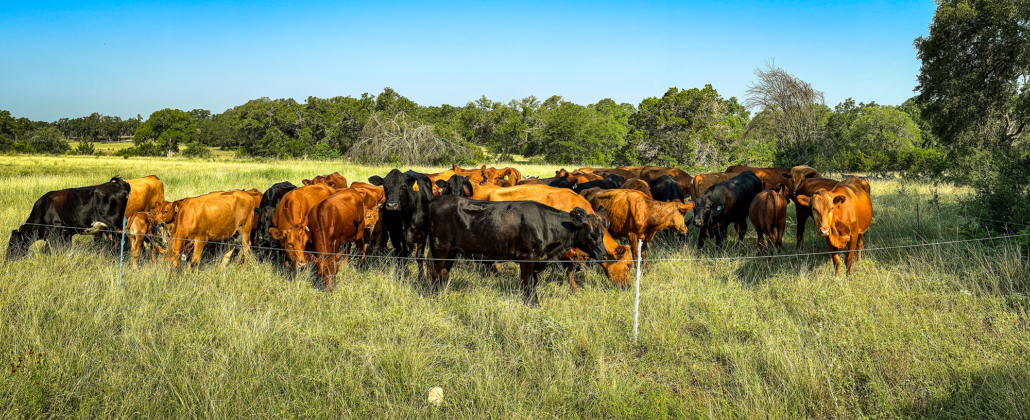
Eubanks’ Safe to Fail Trial. Photo: Darron Gaus, NCAT
The producers in the Texas working group were eager to perform Safe to Fail Trials. The working group hosted in-person workshops where local producers learned about the trials and gained the knowledge to try these trials out on their own ranches. We saw these low-risk, small-scale trials beginning to break down some of the barriers to adoption of regenerative grazing methods noted by the working group: providing on-the-ground evidence and helping overcome fears of going against the community status quo.
Learn More about Safe to Fail Trials
Safe to Fail Trials with Graeme Hand (ATTRA webinar)
Safe to Fail Trial Toolkit (coming soon)
Case Study: Lauri Celella
Poetry, Texas
Lauri Celella ranches in northeast Texas, near the small town of Poetry, with her husband, Dave. Dave is a veterinarian and operates a clinic on their land, while Lauri is a student of Holistic Management who has been practicing regenerative grazing for several years. She was already familiar with the concept of Safe to Fail Trials and happy to set up a trial for our program in the summer of 2023. Lauri even went an extra step and conducted two trials: one with sheep and one with cattle. She gave us a fabulous learning experience. Those who attended field days at her operation got to see low-stress animal movements in high-density situations firsthand and walked away with a valuable tool to take back to their own operations.
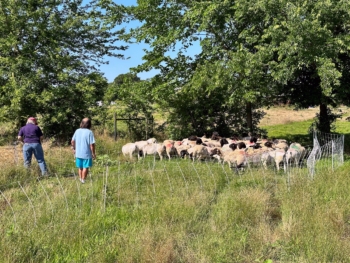
Celella’s Safe to Fail Trial with sheep. Photo: Darron Gaus, NCAT
Lauri set up two trial paddocks. The one for sheep was sized to allow one square yard for each animal. The one for cattle was sized to allow three square yards per bovine. She used a Premier electric net fence to make a lane, along with three strings of portable electric polywire. Lauri conducted her trials simultaneously, keeping the animals packed tightly into their pens for approximately two hours before releasing and excluding them.
Because Lauri had already been practicing regenerative grazing, her livestock were accustomed to being in small paddocks and moving frequently. Both sheep and cattle showed little stress or discomfort during the trial period, although Lauri advises producers who have not been using some form of planned grazing to spend a few weeks training their animals before conducting a Safe to Fail Trial. They need to become familiar with the fencing type used, movements to new paddocks, and proximity to each other.
At this point, Lauri’s two paddocks have been recovering for ten months. She notes that, “The inside is growing much faster than the outside,” and she sees the primary benefit of a Safe to Fail Trial as learning to read the land, to watch and learn how the land and grasses recover. “I see what kinds of new grasses are coming in, what is happening to the weeds, and overall ground cover,” says Lauri. Because she has found Eastern Gamma grass coming up in some bar ditches that do not get mowed, she is hoping to see Eastern Gamma grass show up in her trial paddocks with the longer recovery time. One thing she knows so far is that there are far fewer weeds inside the trial paddocks than outside.
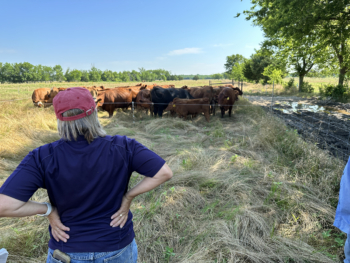
Celella’s Safe to Fail Trial with cattle. Photo: Darron Gaus, NCAT
When we asked Lauri if she would recommend conducting a Safe to Fail Trial to other producers, her answer is a swift, “For sure!” Learning from her own trials has given Lauri the confidence to begin holding on-farm educational events. “I’m planning to do several to share what we’re doing and how to do it.” A champion for peer-to-peer learning, Lauri believes that a Safe to Fail Trial can break down barriers to the adoption of regenerative grazing, helping producers understand that livestock density is not the problem – it does not kill the grass. It is re-grazing before roots can recover that is the issue. Regarding monitoring during the recovery time, Lauri recommends at least taking a monthly photo. “I just set an alarm on my phone, so I remember to take the photos. You think you will remember, but you don’t.”
Case Study: Servando Leal
Bruni, Texas
Servando Leal ranches near Bruni, Texas, in far South Texas, east of Laredo. A native of his South Texas environment, Servando was also eager to conduct a Safe to Fail Trial with support from the working group, to see what he could learn and share with others. Servando’s philosophy about risk is that the biggest risk is to do nothing at all. “We have to be open-minded,” commented Servando. “In this case—trying to be better stewards of the land and be more effective in how we graze—I like to challenge myself.”
When Servando realized that the trial paddock for his cattle would be sized at just three square yards per animal, he didn’t know how his cattle would react. But the day he executed the trial was beautiful, and all went very well. Next time he does a Safe to Fail Trial, he wants to scale up and set up a trial to cover four to five acres, letting that area rest afterward for 12 months. He believes a larger trial will give him the knowledge and experience he needs to think about scaling up across his whole ranch.

Servando Leal’s Safe to Fail Trial before cattle entered.
Photo: Darron Gaus, NCAT
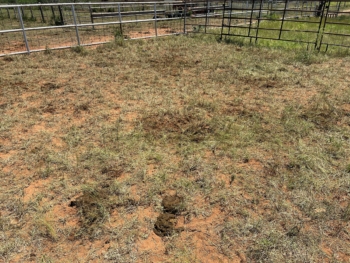
Servando Leal’s Safe to Fail Trial after cattle left. Photo: Darron Gaus, NCAT
Servando commented that the trial gave him a “world of knowledge.” He shared the trial experience with a group of ranchers and NRCS (Natural Resources Conservation Service) personnel whom he invited to watch, and he plans to invite them back after one year to look at the paddock and repeat the trial again. “I’m seeing stuff we haven’t seen before, and the KR bluestem [an invasive] is less,” says Servando. He loves the forage cover response to the trial and is eager to see how much more forage he can stimulate with another trial.
In drought-prone South Texas, Servando’s goal is to learn how to build drought resilience into his land by regenerating the soil. “I want to focus on how much better we are doing during the least amount of rainfall. That would be the true test.”
What advice would Servando give to another producer? “Get out of your own way!” He encourages ranchers to spend more time with their livestock. Move them to new paddocks. Walk among them while they are grazing. Like Lauri, Servando recommends getting animals trained before conducting a Safe to Fail Trial.
In his quest to learn all he can, Servando is becoming a leader in his ranching community. He is involved with the Texas Grazing Land Coalition and his Soil and Water Conservation District board. He is sharing his learning with his community and encouraging his neighbor ranchers to think a bit differently. He hopes they become more comfortable with making changes. “If we are going to succeed in the cattle business, we have to become more observant,” he says.
The Texas Trials
In 2016, NCAT’s Soil for Water team set up monitoring transects on about a dozen ranches in Central Texas to collect data and learn how land responds to various grazing management approaches. Shortly after the monitoring trial began, a multi-year drought set in. The project then became more of a study of how land responds to drought. The study has also taught us a lot about barriers to adoption of regenerative grazing and how producers are coping with and overcoming those barriers.
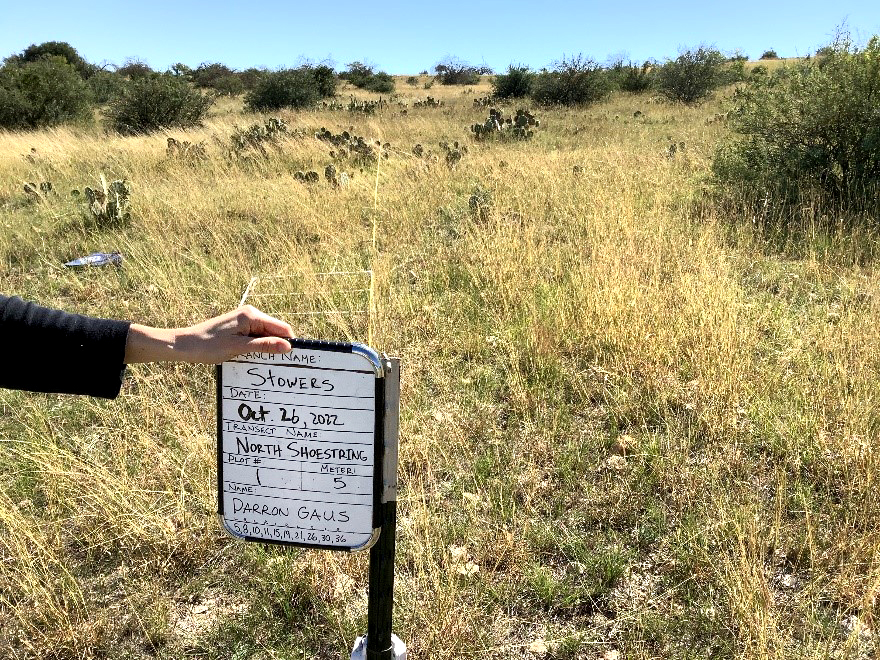
Stower’s Ranch observation. Photo: Darron Gaus, NCAT
Case Study: Ward Whitworth
Harper, Texas
Ward and Barbara Whitworth live on a 1,300-acre ranch about 27 miles northwest of the small Central Texas town of Harper. Ward’s family has been ranching in this area for four generations. Ranching practices were mostly handed down from each preceding generation, although Ward has always been interested in learning from other ranchers and professionals, as well. He attends conferences around the state and came to some Soil for Water meetings, where he spent time visiting with guest speaker Walt Davis, the late, great author of the book How to Not Go Broke Ranching. Ward decided to apply on his ranch what he was learning about increasing the number of pastures and managing grazing and recovery times. He successfully applied to the NRCS Environmental Quality Incentives Program (EQIP), which provided funding to implement the conservation practice Prescribed Grazing.
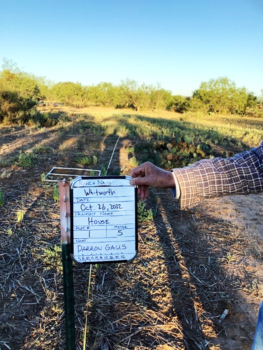
Ward Whitworth’s observations. Photo: Darron Gaus, NCAT
“When we first implemented this type of grazing, I was working with a six-month recovery time. I soon realized six months wasn’t enough, and I began planning a longer recovery time, but then the drought set in,” explains Ward. The past three years have been rough. The Whitworth ranch sat within the deep red circle on the Texas Drought Monitor map designated as “Exceptional Drought” for most of that time. In the spring of 2024, Ward was ready to move his livestock off the ranch and give it a much longer recovery time – meaning until sufficient rainfall allows the land to fully recover.
As Ward reflects on lessons learned, he said he would advise other ranchers to look at their land and their forage species regularly. He became aware after listening to a local ranch community leader that a longer recovery time allowed for more and better perennial native grass species to show up. Learning from his ranching peers has been important to Ward, and he is willing to share his learnings as well. “I’m learning to admit that I have failed. Sometimes it’s important to own it in order to move forward and not ignore it.”
Ward reflects, “My big mistake was lack of awareness of soil health. It’s a big deal. I know some people who know a lot about soil health and still talk about grazing in the wrong way. They’re judging how they’re going to graze based on what’s above the ground and not accounting for what’s happening below the ground. That’s been me for so long. I think we still have a lot of education to do.”
Ward is hoping that he supported his land well enough so that when the rain finally comes, the land will respond quickly and favorably. We hope so too. We can’t wait to help him collect monitoring data when that day arrives.
Case Study: Richard Smith and Sean Kendrick, Stowers Ranch
Hunt, Texas
Stowers Ranch was established in 1904 by George Stowers. Today the 11,800-acre ranch is operated by George’s grandson, Richard Smith, along with Smith’s adult children – George’s great-grandchildren. The multi-generational family has always been conservation-minded. Sheep and goats were removed from the ranch in the 1960s with the recognition that their browsing and grazing were overly competitive with the wildlife and cattle. Richard Smith became interested in and a student of Holistic Management soon after Allan Savory came to Texas in the late 1970s. Richard and his ranch manager began practicing some of the earliest forms of grazing management with wagon wheel pastures. They learned from successes and mistakes and have re-designed the pastures now into 24 pastures across the ranch that facilitate flow of movement and ranch goals to manage as similarly to nature as possible.
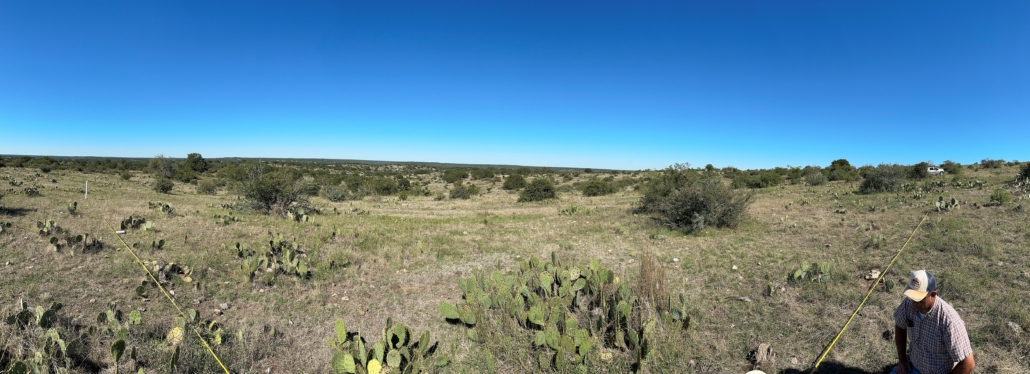
After years of drought, Stowers Ranch land is still biodiverse. Photo: Darron Gaus, NCAT
Stowers ranch sits at the headwaters of the Guadalupe River – a major river flowing to the Gulf Coast. This land is hilly and very rocky. Sean Kendrick has been the ranch manager for the Smiths for 15 years. When drought began in 2021, Sean increased recovery time for each pasture to a minimum of 90 days in fast growth. He’d love to have a 400-day recovery period if he could. He uses Pasture Maps for recordkeeping so he can monitor where the cattle are, when they are there, and for how long. He carefully watches pasture growth. He explains, “For example, in Pasture #1, I don’t want to go back in for 120 days, but if we get seven inches of rainfall I would go back sooner.” Sean’s experience has mostly been on large ranches, and he notes that the cost of cross-fencing can be a large hurdle.
His lessons for others? Get more roots in the ground! If ranch income was not part of the equation, Kendrick says he would pull all the cows for five years, then reintroduce them. “Rocky soils are so different than productive soils,” he states. His perspective on barriers to adoption has been gained from his interactions with other ranchers. “When old-time ranchers hear about regen ranching from non-ranchers, they don’t take it seriously,” states Sean. “And they need real-life models to prove it.” This points to the value of peer-to-peer learning.

Native grasses remain through drought. Photo: Darron Gaus, NCAT
Despite the challenges of rocky, shallow soils and drought, decades of wanting to follow nature’s principles and applying several styles of grazing management seem to have made a big difference. The Stowers Ranch monitoring data has confirmed that their overall land health is better than other ranchers in the Hill Country. And Area 2 of the Texas Soil and Water Conservation Board agreed by awarding Stowers Ranch their Conservation Rancher of the Year Award. Stowers Ranch offers an excellent model for demonstrating the benefits of regenerative grazing.
Take-home Messages from the Texas Working Group
- Be open-minded about the possibilities you can achieve on your ranch.
- Observe the land and forage species often. Develop a technique of reading the land.
- Foster an awareness of soil health. Develop your grazing system based on what’s below the ground as well as what’s above-ground.
- Follow nature’s principles by applying a diversity of grazing management techniques including timing, animal density, and recovery period.
- Longer recovery periods allow for more and better perennial native grass species to show up in pastures.
- Overcome the community “status quo” by learning from each other through supportive peer groups.
- Consider using low-risk, small-scale trials to provide on-the-ground evidence to help overcome fears of adopting regenerative grazing techniques.
- Make sure animals are trained to fencing, movement, and high-density situations before conducting a Safe to Fail Trial.
- Own your failures. Ignoring them is an impediment to moving forward.
A New Paradigm Emerging in Texas
Barriers to adopting new practices can be found across a wide spectrum. We’ve already mentioned going against the status quo and lack of evidence as the two barriers ranked highest by the Texas working group. When we think about going against the status quo, we mostly think about the resistance by individual ranchers. However, when we look deeper into this barrier, we find another highly influential factor: Texas’s 1862 Land Grant university.
Texas A&M University has always been a strong leader and a powerful influence on agricultural practices within the state. In the 1960s, the Merrill 3-herd/4-pasture grazing system was taught at Texas A&M, along with a rest/rotation system, both calendar-driven. In the late 1970s, Allan Savory came to Texas and introduced a new approach to grazing management that was more ecologically driven. Many of the principles of Savory’s method are embedded in today’s modern regenerative grazing principles. However, in the late 1970s and early 1980s, Savory compromised his own endeavor by generating conflict with Range Management professors and researchers in the Texas A&M system. In addition, the Savory method was not well explained or well understood, resulting in some early research ending with disastrous results. These events “poisoned the well” and became a major barrier in Texas. During the 1980s and 1990s, members of the Texas A&M Range Management Department and the Research division, along with other academic institutions in Texas, actively endeavored to discredit the Savory method.
During that same time period, new research in soil health and soil function began emerging in the United States and around the world. These new principles of soil health have, over time, merged with the principles of planned grazing and been applied by early adopters in Texas and elsewhere, despite academic resistance. Increasing scientific studies over the past two decades have expanded our understanding of the relationships between grazing management and soil health and function. Regenerative grazing was born, and a younger generation of range students in Texas, exposed to this emerging science, are now becoming leaders in their field.

Texas Grazing Lands Coalition meets with Servando Leal. Photo: Darron Gaus, NCAT
For example, in 2024, a newly revived Center for Grazinglands and Ranch Management at Texas A&M, under the leadership of Dr. Jeff Goodwin, is partnering with several universities and other organizations on a $19 million research project to expand understanding of grazing practices and their impact on soil health and soil function. Among other partners, the Center is collaborating with the Texas Grazing Lands Coalition to launch a series of workshops around the state introducing ranchers to soil health principles and their relationship to grazing practices. Over time, the Center’s research should provide much-needed evidence about the effectiveness of regenerative grazing and reduce pressure to “go with the status quo.”
Learn more about the Center for Grazinglands and Ranch Management:
Learn more about the Texas Grazing Land Coalition:
The support for this Center signals not only a major shift in attitudes at Texas A&M, but also the emergence of a new paradigm in the Texas agricultural community—one that includes a strong focus on improving soil health and the functioning of water cycles. After all, what matters most to rangeland health is not just the amount of rain that falls, but how much of that rain soaks into soil and stays there long enough to be available to plants (Thurow, 1991).
In a drought-prone state like Texas, many agencies and organizations should be able to rally around this point. At the same time, agricultural nonprofit organizations are partnering to further spread new grazing and soil health principles and practices to landowners. Peer-to-peer meetings, field days, and a steady stream of workshops and other educational events are contributing to the acceptance of this new paradigm. For the first time in many decades, Texas is ripe for a leap toward the widespread adoption of regenerative grazing.
References
Thurow, T. 1991. Hydrology and erosion. p. 141–159. In: Grazing Management: an ecological perspective. Heitschmidt R. K., and J. W. Stuth (eds.). Timberland Press, Portland, OR.
Further Resources
Soil for Water
NCAT’s Soil for Water project website celebrates the amazing water-holding ability of healthy soil and encourages on-farm research and discovery. It includes a story collection, peer-to-peer learning opportunities, and resources for farms and ranches interested in catching and holding more water in their soils.
Managing Soils for Water: How Five Principles of Soil Health Support Water Infiltration and Storage
Too often, the approach to dealing with water deficits has focused exclusively on better technology: deeper wells, better drip emitters, more efficient micro-sprinklers, and variable-speed drives on pumps. While all of these are important, this publication discusses a different approach that focuses on maintaining healthy soils by following five basic principles.
Grazing Networks for Livestock Producers
Grazing networks promote a mutual self-help approach to learning that is based on shared local experience and provides several benefits to participants. This publication offers suggestions for finding or starting a grazing network and provides examples of the kinds of activities grazing networks might conduct. It also contains recommendations for sustaining a grazing network over time.
Holistic Management International
Holistic Management helps family farmers/ranchers/ pastoralists become more prosperous, helps strengthen local economies, improves local food quality, heals the environment, improves wildlife habitats, fosters community ties, and preserves local culture.
The Center for Grazinglands and Ranch Management
This is a Texas A&M University System-wide coordinated effort with the mission of safeguarding the ecologic and economic resiliency of grazing land resources and ranching operations.
Acknowledgment
This publication is based upon work that is supported by the National Institute of Food and Agriculture, U.S. Department of Agriculture, under award number 2020-38640-31521 through the Southern Sustainable Agriculture Research and Education program under subaward number LS21-345. USDA is an equal opportunity employer and service provider. Any opinions, findings, conclusions, or recommendations expressed in this publication are those of the author(s) and do not necessarily reflect the view of the U.S. Department of Agriculture.
![]()

